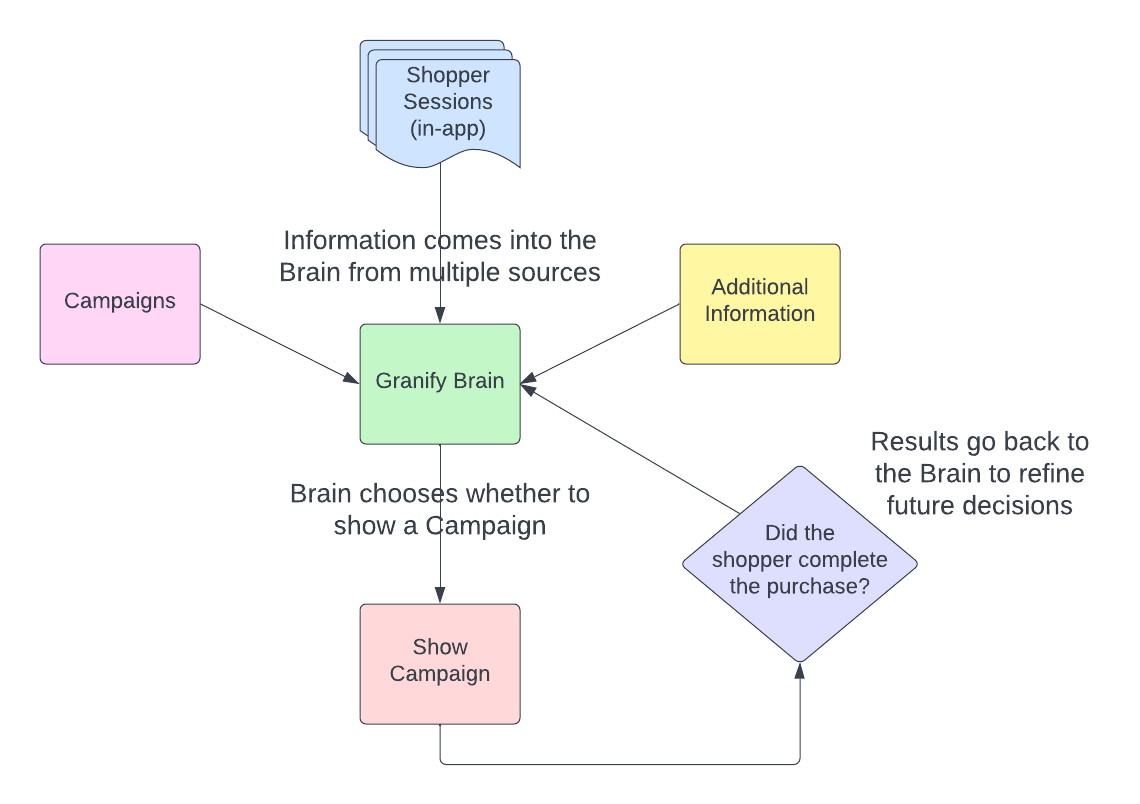How Does Granify Work
Overview
Granify is an e-commerce integration that augments your shopping app by showing the shopper smart messages (which we call campaigns) designed to optimize the path to conversion through their shopping journey. We decide which campaigns to show, where to show them, and to which shoppers, using our state-of-the-art Granify Brain.
For any online store, there are three types of shopper: those who will definitely make a purchase, those who will definitely not (eg: can’t afford the prices, don’t like the products, etc), and those who are not entirely sure, and might go either way. That last group is Granify’s primary target. We monitor shoppers’ behavior, and show encouraging messages at opportune points in the shopper’s journey in an attempt to convert a shopper from a “maybe” to a “yes”.
Showing a shopper an encouraging message can be extremely effective in increasing purchase conversions, but only if it is the right message, to the right shopper at the right time. Otherwise the messages are just irritating, and have the opposite effect. At Granify, we understand this, and we’ve made it our mission to find that sweet spot that maximizes effectiveness while minimizing irritation.

Monitoring The Shoppers
For this whole system to work, we require a lot of information about the shopper and their activity. The more information we can get, the better. We need to know what pages they visit, for how long, and how much time they tend to spend between visits. We’re interested in which products they look at, and which they just ignore. We monitor how far down a page they scroll, and how long they spend at each section. We are particularly interested in what items they add into their cart, and which ones they remove again, and so on and so on. In the web app, we collect up to 500 distinct data points every second, and our iOS app SDK is closing in on this fast.
Some of this information we can glean just from being included in the app (eg: active vs suspended times), some you must give us explicitly (eg: which pages are viewed, which products, etc), and some we can glean from the access you give us (eg: the UIScrollView object in the trackPageView method call).
In some cases, you may have to decide whether to provide Granify with some information or not. In every case, we encourage you to provide us with as much information as you possibly can. The more information we have, the more effective we can be, and the more money your company will make from our partnership.
Additional Information
In addition to the information sent to the Granify Brain from all the shoppers’ sessions, we also sometimes collect information directly from our clients through data feeds. These would typically be product catalogues, but may also include purchase histories, and other useful information.
Granify Brain
We collect all this information, and pour it into the Granify Brain. The Brain uses all that information to decide whether it would be appropriate to show a particular shopper a campaign, which campaign to show, and when in their journey to show it.
Campaigns
Our account managers will work with your team to compile the set of campaigns that will be available to display in your app. These may be standard campaigns we already have available, or custom campaigns written just for your app. Campaigns may differ visually (colors, layout and so on), have different copy, or have different trigger requirements. For example, a campaign that recommends that the shopper purchase an item in their cart before it is out of stock, can obviously only be shown to shoppers with an item in their cart that is low on stock.
This collection of campaigns provides the Brain with the pool of available campaigns. It is not uncommon to have 100 campaigns active at a time.
Monitoring Results
None of this would be effective at all if we did not also monitor the effectiveness of our campaigns, and use that information to refine our decision engine. Using the time-honored scientific method, Granify divides shoppers into two groups - the baseline (or control) group, and the Granify group. Both groups are monitored the same and the Brain makes decisions for both the same way, but for the baseline, no actual campaign is shown. We record that case as “would have shown” instead of “shown”.
Using this split, we can easily tell whether Granify has had any effect on the number of shoppers who complete purchases. We can identify this information on a macro scale for all campaigns, and we use that for billing, but also at a campaign level, and we use that information to refine the Brain’s decision making, and continuously improve the service we provide.
 How Does Granify Work Reference
How Does Granify Work Reference